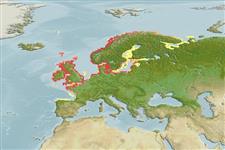Environment: milieu / climate zone / depth range / distribution range
Ecology
Marine; brackish; benthopelagic; non-migratory; depth range 1 - 6 m (Ref. 130221). Temperate; 71°N - 43°N, 11°W - 55°E
Northeast Atlantic: north-western Europe.
Size / Weight / Age
Maturity: Lm ? range ? - ? cm
Max length : 22.0 cm SL male/unsexed; (Ref. 4119)
Dorsal spines (total): 14 - 17. Front of body brassy-yellow in the male, with larger pectoral fins than in the female (Ref. 35388).
Adults live solitary or in pairs in weedy, shallow coastal areas (Ref. 4119). Feed on small invertebrates (Ref. 4119). Males build a nest from algae and debris, using kidney excrete as glue. Spawning season is May to June. Females deposit 150 - 200 eggs in the nest and often die shortly afterwards (Ref. 9900). Males care for and defend the nest. Offsprings reach maturity in one year (Ref. 4645).
Males build, guard and aerate the nest where the eggs are deposited (Ref. 205). Also Ref. 53335.
Muus, B.J. and P. Dahlström, 1974. Collins guide to the sea fishes of Britain and North-Western Europe. Collins, London, UK. 244 p. (Ref. 173)
IUCN Red List Status (Ref. 130435)
Threat to humans
Harmless
Human uses
Fisheries: of no interest
Tools
Special reports
Download XML
Internet sources
Estimates based on models
Preferred temperature (Ref.
123201): 7.5 - 12.5, mean 9.9 °C (based on 512 cells).
Phylogenetic diversity index (Ref.
82804): PD
50 = 1.0000 [Uniqueness, from 0.5 = low to 2.0 = high].
Bayesian length-weight: a=0.00468 (0.00205 - 0.01068), b=3.04 (2.83 - 3.25), in cm total length, based on LWR estimates for this (Sub)family-body shape (Ref.
93245).
Trophic level (Ref.
69278): 3.5 ±0.37 se; based on food items.
Resilience (Ref.
120179): High, minimum population doubling time less than 15 months (K=1.78; tm=1).
Fishing Vulnerability (Ref.
59153): Low vulnerability (17 of 100).
Nutrients (Ref.
124155): Calcium = 35 [8, 105] mg/100g; Iron = 0.37 [0.14, 1.25] mg/100g; Protein = 2.67 [0.00, 6.47] %; Omega3 = 0.522 [0.226, 1.292] g/100g; Selenium = 9.45 [1.54, 29.35] μg/100g; VitaminA = 19.8 [6.0, 61.4] μg/100g; Zinc = 0.842 [0.413, 1.601] mg/100g (wet weight);
